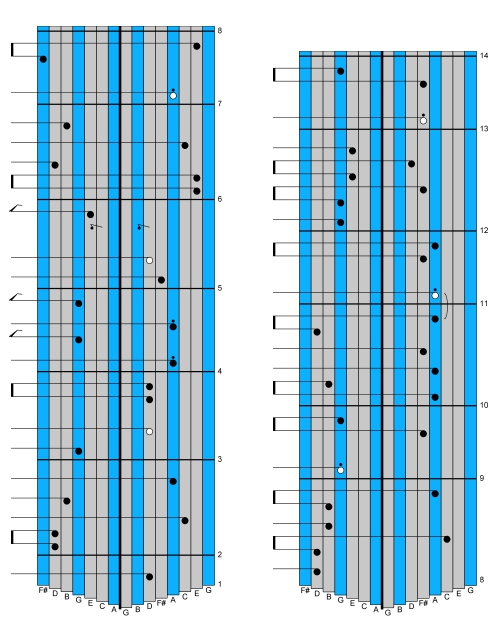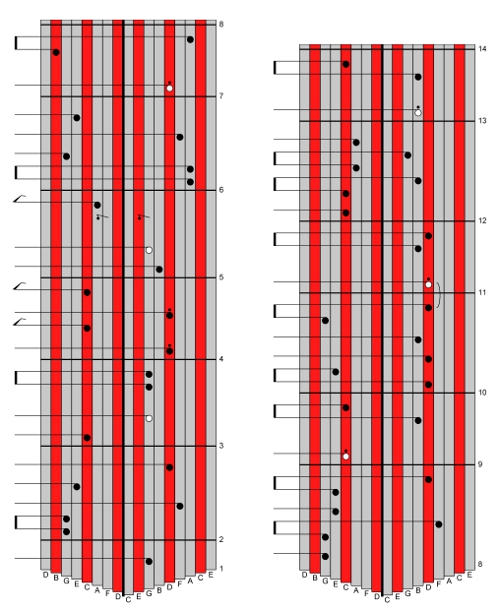The classic holiday song “Let it Snow” has a great trick that usually doesn’t work on the kalimba. Some songs, including this one, modulate to a different key temporarily. Usually, when you modulate to another key, you have “accidentals” – that is, notes that are not in the original key, or even on the kalimba! Well, “Let it Snow” can be played happily on your kalimba with a bit of musical sleight-of-hand.
You can hear the modulation in “Let it Snow” – it happens in the bridge at 0:42 in the video. At that point, another note and another chord temporarily become “home base.” How do you think I will navigate this?
This song isn’t in any of our music books – it is just a holiday gift from Kalimba Magic to you. The video is performed on the Hugh Tracey Alto kalimba, usually tuned to G, but mine is tuned down to F. I do this because my voice doesn’t go as high as it used to. I’ve tuned the Alto down to make it easier for me to sing with it.
By the way, if you want to retune your kalimba to a different key, you can usually tune it down a half step or a whole step (as I did in going from G to F). If you tune down any further, the tines will start falling off the kalimba, because they aren’t long enough to be pulled out that far. You can tune the kalimba up a few whole steps. If you want to go up a 4th, instead of pushing or pulling all the tines, consider tuning around the circle of 5ths, which means leaving most tines unchanged, but adding one or more sharps or flats. When you do this, the low note of your kalimba will not change – so in the new key, that low note is no longer the root note, but some other degree of the scale.
Below is page 1 of the Alto tab – click on the image to download the full 2-page PDF.

Click to download the Alto Tablature PDF
Below is page 1 of the tab for the 17-Note Kalimba – click on the image to download the full 2-page PDF.

Click to download the Tablature PDF for 17-Note Kalimba in C
By the way, if you want to understand the relation between Alto kalimbas and 17-Note Kalimbas in C and their tablature, take a look at the two images above. The note names are totally different, but the painted tines and the roles each tine plays in the scale will be the same in both kalimbas. OK… the 17 note kalimba does have two extra notes compared to the 15-Note Alto kalimba. Those extra notes are the unpainted tines on the far left and the far right, D and E. But, if you ignore those two extra tines and the names of the notes, the tablature for these two kalimbas is identical.
What does that mean? It means that if you own an Alto and a 17-Note kalimba in C, even though you would not be able to play them at the same time (because they are in different keys) you would perform the exact same thumb motions on the two kalimbas to achieve the song “Let It Snow.” In other words, if I had learned this song on the Alto kalimba, I could play it without any new learning on the 17-Note in C. (Just think of the flexibility you would have – accommodating a singer’s voice, or playing with other instruments in either of these two keys.)
And THAT, in a nutshell, is why I paint the 17-Note C kalimbas this way, with six painted tines.
Now – back to the mystery of the magical modulation. The tablature actually skips the second verse (which is just like the first), and the bridge starts at measure 10, modulating to the key of D for the Alto, or the key of G on the 17-Note in C. In either case, a sharp has been added (C# or F#) – that is, the song requires a note that is not on the kalimba. How do I finesse this?
The first part of the bridge actually doesn’t use that new note in the melody. The missing sharp doesn’t come in until I sing “all the way home I’ll be warm” at measure 16. Of course, my voice can sing the note that is missing on the kalimba, and that is exactly what I do. The worse thing I could do is to then sing the correct note and play the wrong note on the kalimba – the two very-close-but-not-identical notes will clash badly.
Instead, what I do is to play a line on the kalimba that harmonizes with the melody I sing… and unless you are paying very close attention, you would have no idea that anything strange is going on.
If you find yourself in a situation where you need a note the kalimba doesn’t have, try singing that note, and playing another complementary note on your kalimba. It is a really great trick!


Sign up for our newsletter and free resources with your email address:
We pinky promise not to spam you and to only send good stuff.
 Christmas in July 2025
Christmas in July 2025 Patriotic and American Music for Kalimba
Patriotic and American Music for Kalimba